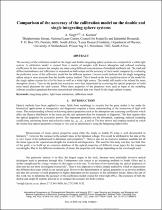 ResearchSpace
ResearchSpace
Comparison of the accuracy of the calibration model on the double and single integrating sphere systems
JavaScript is disabled for your browser. Some features of this site may not work without it.
- ResearchSpace
- →
- Research Publications/Outputs
- →
- Conference Publications
- →
- View Item
| dc.contributor.author |
Singh, A

|
|
| dc.contributor.author |
Karsten, A

|
|
| dc.date.accessioned | 2011-10-14T08:29:52Z | |
| dc.date.available | 2011-10-14T08:29:52Z | |
| dc.date.issued | 2011-05 | |
| dc.identifier.citation | Singh, A and Karsten, A. 2011. Comparison of the accuracy of the calibration model on the double and single integrating sphere systems. International Symposium on Photoelectronic Detection and Imaging: Laser Sensing and Imaging; and Biological and Medical Applications of Photonics Sensing and Imaging, May 24-26 2011, Beijing, China, May 2011. Proc. of SPIE Vol. 8192 | en_US |
| dc.identifier.uri | http://hdl.handle.net/10204/5238 | |
| dc.description | Copyright: 2011 Society of Photo‑Optical Instrumentation Engineers (SPIE). One print or electronic copy may be made for personal use only. Systematic reproduction and distribution, duplication of any material in this paper for a fee or for commercial purposes, or modification of the content of the paper are prohibited. | en_US |
| dc.description.abstract | The accuracy of the calibration model for the single and double integrating sphere systems are compared for a white light system. A calibration model is created from a matrix of samples with known absorption and reduced scattering coefficients. In this instance the samples are made using different concentrations of intralipid and black ink. The total and diffuse transmittance and reflectance is measured on both setups and the accuracy of each model compared by evaluating the prediction errors of the calibration model for the different systems. Current results indicate that the single integrating sphere setup is more accurate than the double system method. This is based on the low prediction errors of the model for the single sphere system for a He-Ne laser as well as a white light source. The model still needs to be refined for more absorption factors. Tests on the prediction accuracies were then determined by extracting the optical properties of solid resin based phantoms for each system. When these properties of the phantoms were used as input to the modeling software excellent agreement between measured and simulated data was found for the single sphere systems. | en_US |
| dc.language.iso | en | en_US |
| dc.publisher | SPIE | en_US |
| dc.relation.ispartofseries | Workflow request;7405 | |
| dc.subject | Integrating sphere | en_US |
| dc.subject | Light tissue interaction | en_US |
| dc.subject | Calibration model | en_US |
| dc.subject | Photoelectronic detection | en_US |
| dc.subject | Laser imaging | en_US |
| dc.subject | Laser sensing | en_US |
| dc.subject | Photonics sensing | en_US |
| dc.subject | Photonics imaging | en_US |
| dc.title | Comparison of the accuracy of the calibration model on the double and single integrating sphere systems | en_US |
| dc.type | Conference Presentation | en_US |
| dc.identifier.apacitation | Singh, A., & Karsten, A. (2011). Comparison of the accuracy of the calibration model on the double and single integrating sphere systems. SPIE. http://hdl.handle.net/10204/5238 | en_ZA |
| dc.identifier.chicagocitation | Singh, A, and A Karsten. "Comparison of the accuracy of the calibration model on the double and single integrating sphere systems." (2011): http://hdl.handle.net/10204/5238 | en_ZA |
| dc.identifier.vancouvercitation | Singh A, Karsten A, Comparison of the accuracy of the calibration model on the double and single integrating sphere systems; SPIE; 2011. http://hdl.handle.net/10204/5238 . | en_ZA |
| dc.identifier.ris | TY - Conference Presentation AU - Singh, A AU - Karsten, A AB - The accuracy of the calibration model for the single and double integrating sphere systems are compared for a white light system. A calibration model is created from a matrix of samples with known absorption and reduced scattering coefficients. In this instance the samples are made using different concentrations of intralipid and black ink. The total and diffuse transmittance and reflectance is measured on both setups and the accuracy of each model compared by evaluating the prediction errors of the calibration model for the different systems. Current results indicate that the single integrating sphere setup is more accurate than the double system method. This is based on the low prediction errors of the model for the single sphere system for a He-Ne laser as well as a white light source. The model still needs to be refined for more absorption factors. Tests on the prediction accuracies were then determined by extracting the optical properties of solid resin based phantoms for each system. When these properties of the phantoms were used as input to the modeling software excellent agreement between measured and simulated data was found for the single sphere systems. DA - 2011-05 DB - ResearchSpace DP - CSIR KW - Integrating sphere KW - Light tissue interaction KW - Calibration model KW - Photoelectronic detection KW - Laser imaging KW - Laser sensing KW - Photonics sensing KW - Photonics imaging LK - https://researchspace.csir.co.za PY - 2011 T1 - Comparison of the accuracy of the calibration model on the double and single integrating sphere systems TI - Comparison of the accuracy of the calibration model on the double and single integrating sphere systems UR - http://hdl.handle.net/10204/5238 ER - | en_ZA |





